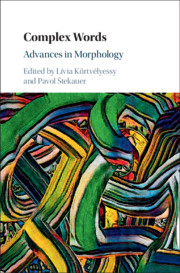Book contents
- Complex Words
- Complex Words
- Copyright page
- Dedication
- Contents
- Contributors
- Introduction: Advances in Morphology
- Part I Lexico-Semantic Aspects of Complex Words
- 1 Formal Semantics and the Problem of Nominalizations
- 2 Semantically Subtractive Morphology
- 3 -less and -free
- 4 Instrument Nouns in -one in Latin and Romance
- 5 Prominence in Noun-to-Verb Conversion
- 6 On Spanish Dvandva and Its Restrictions
- Part II Structure of Complex Words
- Part III Corpus-Based Case Studies
- Index
- References
4 - Instrument Nouns in -one in Latin and Romance
from Part I - Lexico-Semantic Aspects of Complex Words
Published online by Cambridge University Press: 18 September 2020
- Complex Words
- Complex Words
- Copyright page
- Dedication
- Contents
- Contributors
- Introduction: Advances in Morphology
- Part I Lexico-Semantic Aspects of Complex Words
- 1 Formal Semantics and the Problem of Nominalizations
- 2 Semantically Subtractive Morphology
- 3 -less and -free
- 4 Instrument Nouns in -one in Latin and Romance
- 5 Prominence in Noun-to-Verb Conversion
- 6 On Spanish Dvandva and Its Restrictions
- Part II Structure of Complex Words
- Part III Corpus-Based Case Studies
- Index
- References
Summary
Meyer-Lübke and his followers attributed the instrumental function of Romance deverbal nouns in -one to the metaphorical extension of corresponding agent nouns. In the present contribution, I argue that no such extension has ever taken place. Rather, the instrumental function has been inherited from Latin and extended analogically in a small number of semantic niches. Reanalysis of denominal nouns in -one relatable to verbal bases may also have been at stake in some instances.
Keywords
- Type
- Chapter
- Information
- Complex WordsAdvances in Morphology, pp. 65 - 81Publisher: Cambridge University PressPrint publication year: 2020



